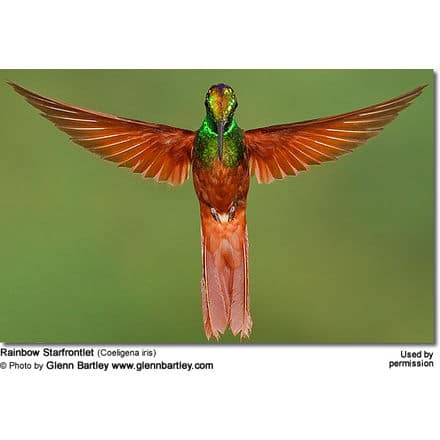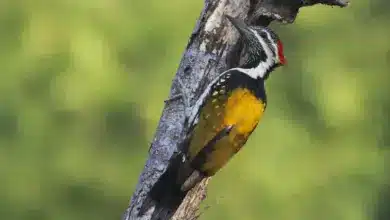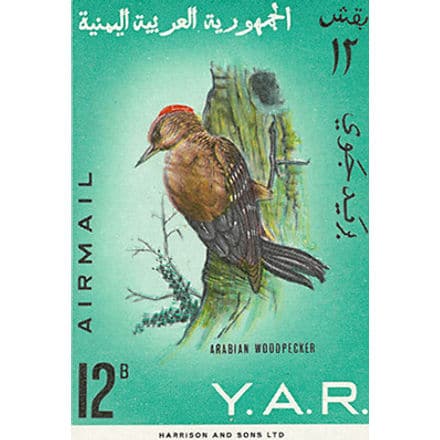Rainbow Starfrontlets – Hummingbirds
Hummingbird Information
The Rainbow Starfrontlets (Coeligena iris) is a large South American hummingbird that is native to Ecuador and Peru, where they are fairly common. They inhabit subtropical or tropical humid montanes, high-altitude shrubland, and heavily degraded former forests – usually at elevations of 1,500 – 3,300 m. They are usually seen along the edges of forests and adjacent shrubby areas.
Subspecies and Distribution:
-
- Coeligena iris iris – Nominate Race (Gould, 1854)
- Range: West slope of the Andes; south Ecuador (Loja) to northern Peru (Piura)
- Coeligena iris hesperus (Gould, 1865)
- Range: Southwestern Ecuador (Cuenca)
Coeligena iris aurora (Gould, 1854)
- Range: Northern Peru (Cutervo, Cerros de Amachonga).
Coeligena iris fulgidiceps (Peters, 1945)
- Range: Amazonas
- [Coeligena iris hypocrita] (Peters,1945) = Proposed race hypocrita, based on juvenile plumage, is synonym of fulgidiceps (= one and the same)
Coeligena iris flagrans (J.T.Zimmer, 1951)
- Range: Peru: west side of Northwest Andes in northwest Cajamarca
Coeligena iris eva (Peters, 1945)
- Range: Peru’s Cajamarca east slope of West Andes at Cajabamba and Succha and west slope of Central Andes at La Libertad Tayabamba
- Coeligena iris iris – Nominate Race (Gould, 1854)
Description:
The Rainbow Starfrontlets average 13.5 – 14 cm (~5.25 – 5.5 inches) in length. The beak is about 2.9 cm (~1.1 inch) long.
The plumage is mostly rufous colored.
Subspecies variations:
- Nominate Coeligena iris and subspecies Coeligena iris fulgidiceps: The male’s foregrown is a glittering green with a blue spot on the crown .
- Subspecies farther south on the west slope of the Andes look alike, but the nape (back of the neck) and upper back is coppery with no black on the neck in the subspecies Coeligena iris flagrans.
- Subspecies Coeligena iris aurora, occurring in northern Cajamarca, has an all-green crown and a blue upper throat; those found in southern Cajamarca have a central blue stripe through the crown.
Females look like males, but have a duller plumage and their throat color is sometimes mixed with buffy.
Nesting / Breeding
Hummingbirds are solitary in all aspects of life other than breeding; and the male’s only involvement in the reproductive process is the actual mating with the female. They neither live nor migrate in flocks; and there is no pair bond for this species. Males court females by flying in a u-shaped pattern in front of them. He will separate from the female immediately after copulation. One male may mate with several females. In all likelihood, the female will also mate with several males. The males do not participate in choosing the nest location, building the nest or raising the chicks.
The female Rainbow Starfrontlet is responsible for building the cup-shaped nest out of plant fibers woven together and green moss on the outside for camouflage in a protected location in a shrub, bush or tree. She lines the nest with soft plant fibers, animal hair and feather down, and strengthens the structure with spider webbing and other sticky material, giving it an elastic quality to allow it to stretch to double its size as the chicks grow and need more room. The nest is typically found on a low, thin horizontal branch.
The average clutch consists of two white eggs, which she incubates alone, while the male defends his territory and the flowers he feeds on. The young are born blind, immobile and without any down.
The female alone protects and feeds the chicks with regurgitated food (mostly partially-digested insects since nectar is an insufficient source of protein for the growing chicks). The female pushes the food down the chicks’ throats with her long bill directly into their stomachs.
As is the case with other hummingbird species, the chicks are brooded only the first week or two, and left alone even on cooler nights after about 12 days – probably due to the small nest size. The chicks leave the nest when they are about 7 – 10 days old.
Diet / Feeding
The Rainbow Starfrontlets primarily feed on nectar taken from a variety of brightly colored, scented small flowers of trees, herbs, shrubs and epiphytes. They favor flowers with the highest sugar content (often red-colored and tubular-shaped) and seek out, and aggressively protect, those areas containing flowers with high energy nectar.They use their long, extendible, straw-like tongues to retrieve the nectar while hovering with their tails cocked upward as they are licking at the nectar up to 13 times per second. Sometimes they may be seen hanging on the flower while feeding.
Many native and cultivated plants on whose flowers these birds feed heavily rely on them for pollination. The mostly tubular-shaped flowers actually exclude most bees and butterflies from feeding on them and, subsequently, from pollinating the plants.
They may also visit local hummingbird feeders for some sugar water, or drink out of bird baths or water fountains where they will either hover and sip water as it runs over the edge; or they will perch on the edge and drink – like all the other birds; however, they only remain still for a short moment.
They also take some small spiders and insects – important sources of protein particularly needed during the breeding season to ensure the proper development of their young. Insects are often caught in flight (hawking); snatched off leaves or branches, or are taken from spider webs. A nesting female can capture up to 2,000 insects a day.
Males establish feeding territories, where they aggressively chase away other males as well as large insects – such as bumblebees and hawk moths – that want to feed in their territory. They use aerial flights and intimidating displays to defend their territories.
Metabolism and Survival and Flight Adaptions – Amazing Facts
Call / Vocalizations:
Their calls are described as a thin “rip” and a high, wiry, squealing chatter that rises and falls in pitch.
Species Research by Sibylle Johnson
Please Note: The articles or images on this page are the sole property of the authors or photographers. Please contact them directly with respect to any copyright or licensing questions. Thank you.





